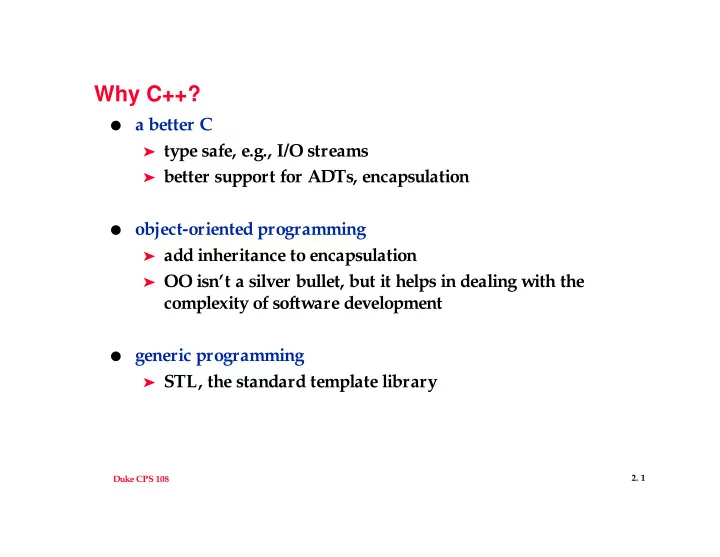

Why C++? ● a better C ➤ type safe, e.g., I/O streams ➤ better support for ADTs, encapsulation ● object-oriented programming ➤ add inheritance to encapsulation ➤ OO isn’t a silver bullet, but it helps in dealing with the complexity of software development ● generic programming ➤ STL, the standard template library 2. 1 Duke CPS 108
Why inheritance? class Shape standard shape example ● { ➤ difficult to extend public: enum Kind {circle,square,...}; ➤ access to source double area() const; ➤ change all functions void rotate(); private: ➤ what is state? Kind myKind; }; double Shape::area() const inheritance ● { switch (myKind) ➤ models is-a { Liskov substitution principle case Shape::circle: ➤ cost? (who pays?) return PI * myDim * myDim; case Shape::square: //... } } 2. 2 Duke CPS 108
Inheritance ● virtual functions provide runtime polymorphism ➤ must use pointers or references ➤ can extend base class without access to source ● in C++ there are several kinds of inheritance ➤ public, private, virtual, ... ➤ multiple inheritance ● we’ll use single, public inheritance, trying to model “is-a” as much as possible ● General goal: base classes are abstract , have one pure virtual function ➤ model an interface, not an implementation ➤ see map hierarchy for example 2. 3 Duke CPS 108
Shapes: C++ features, what is “is-a”? class Shape { public: virtual double area() const = 0; }; class Square : public Shape { public: virtual double area() const {return mySide * mySide;} private: double mySide; }; class Rectangle : public Shape { public: virtual double area() const {return myWidth * myHeight;} }; 2. 4 Duke CPS 108
Designing for change (extension) ● How does inheritance help? ● How to add a new kind of shape to example? ➤ what needs to be changed? ➤ what do you need to know to add it? ➤ how to explain so others can use effectively? ● How to write code to take advantage of changes easily? ➤ think about open/closed principle ➤ write code generically, allowing for possibility for change ➤ heuristic: use a class whenever you think you may change your mind 2. 5 Duke CPS 108
grep.cc ● iterators ➤ internal, external ➤ creation/deletion ➤ use of inheritance and naming conventions ● STL, Duke-classes ➤ what is a templated class/function? ➤ how are templates instantiated? ➤ drawbacks? 2. 6 Duke CPS 108
Data Structures, STL, Generic Programming ● common container classes/data structures ➤ vector grow able array ➤ map dictionary, (seach tree, hashtable) union, intersection, membership ➤ set ● STL, Standard Template Library ➤ not just implementations, but way of thinking ➤ little/no inheritance, lots of templates ➤ algorithms and functions generalized too ● default often not-safe, implementations make heavy use of “new C++ features” 2. 7 Duke CPS 108
Factory Pattern ● Consider classes for different look-and-feel styles Circle c(100, 100, 10); c.area(); Triangle t(100, 100, 10); t.area(); ➤ problems, how to choose shape, when to choose ● Does inheritance help? Shape * s = new Circle(100, 100, 10); s = new Triangle(100, 100, 10); s->area(); ➤ is this better? are there problems? ● Use a Shape Factory Shape * s = factory->makeShape(100, 100, 10); s->area(); ➤ dependencies exist, but in factory ➤ parameters to factory can initialize shape returned 2. 8 Duke CPS 108
Pattern Essentials ● Name ➤ good name provides a handle for the pattern, makes it easy to remember and use: vocabulary ● Problem ➤ when the pattern is applicable, context, criteria to be met, design goals ● Solution ➤ design, collaborations, responsibilities, and relationships of the classes/design elements ● Consequences ➤ trade-offs, problems, results from applying pattern: help in evaluating applicability 2. 9 Duke CPS 108
Design patterns ● Add to vocabulary used to communicate and think about design ● Form part of a tool-kit we use when thinking about design ● Help find solutions to design problems ➤ factory ➤ iterator see usew ords.cc ➤ proxy ➤ also: adapter, singleton, observer, command ➤ also: model-view-controller, client-server, … ➤ GOF, gang-of-four, Gamma, Helms, Johnson, Vlissides 2. 10 Duke CPS 108
Recommend
More recommend